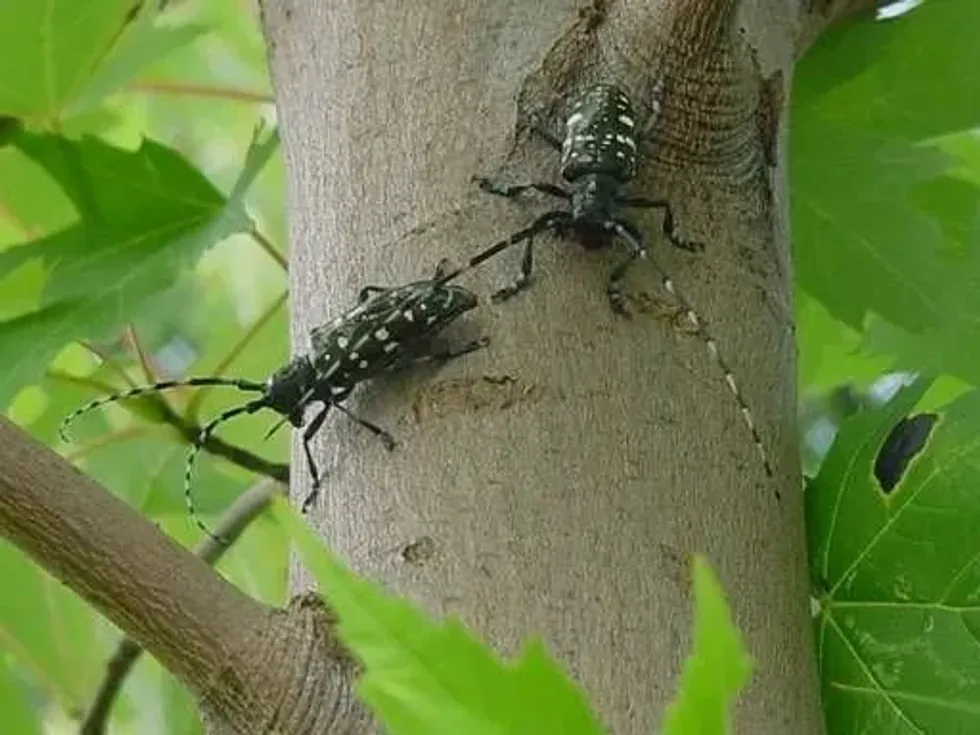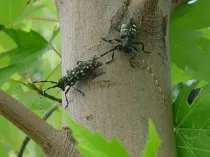For the Asian longhorned beetle, invasive species is how you should best describe them. Asian longhorned beetle (scientific name: Anoplophora glabripennis) is one of the most dangerous invasive species in the world.
While called the Asian longhorned beetle/Asian long-horned beetle in the west, the species also has the names starry sky or sky beetle. This is due to the white spots on their shiny black exoskeletons.
Known for destroying forests and urban trees, this species has long been the dread of many people. While they might look harmless, the damage caused by them can run into millions of dollars.
Originating in Asian countries like China and Korea, they made their way to North America and Europe through infested wood. So, read on if you want to learn more about these invasive pests.
For facts and great information on other beetle species, take a look at the longhorn beetle and golden tortoise beetle.
Asian Longhorned Beetle Interesting Facts
What type of animal is an Asian longhorned Beetle?
The Asian longhorned beetle (Anoplophora glabripennis) is an invasive beetle species that are native to the countries of China and Korea.
These adult beetles have infested places of North America and Europe and are found on tree bark and branches in areas like New York City in America and are a major cause of pest infestation in the New York City area.
What class of animal does an Asian longhorned Beetle belong to?
The Asian longhorned beetle (ALB), or the Asian longhorn beetle, is a beetle species belonging to the class of Insecta or insects.
How many Asian longhorned Beetles are there in the world?
While they are quite widespread over different continents, the exact population of the Asian longhorned beetle (ALB) is not known.
Where does an Asian longhorned Beetle live?
The habitat of the ALB is in the hardwood host tree. The Asian longhorned beetle origin is from China and Japan.
Soon after, it spread from its native place to other continents via solid wood packing from an infested tree.
The wood from the infested tree was exported to various countries and as a result, areas of America like Canada and the United States (New York, South Carolina) became infested with this invasive pest species.
In many places, the bark and branches of the infested trees had to be cut off and the area with the infestation needed quarantine with regular inspection and control. As such, Asian longhorned beetle distribution can be effectively said to be spread over various places.
What is an Asian longhorned Beetle's habitat?
For the Asian longhorned beetle habitat, hardwood trees make for the perfect infestation habitat. The trees that have acted as host to this pest are maple trees, elm trees, willow trees, poplar trees, birch trees, katsura trees, ash trees, and beech trees.
Maple is thought to be one of the most preferred host trees. While living in trees, these beetles are known to make exit holes in the solid wood bark. Each exit holes are around three-eights of an inch in size.
The adults are known to be active in the day and are hence diurnal. Adult males have also been observed to be quite territorial and often engage in fights with each other.
Who do Asian longhorned Beetles live with?
Adults are not really solitary but Asian longhorned beetle larvae spend most of their time within the host trees.
How long does an Asian longhorned Beetle live?
While adults have a survival rate of 66 days for females and 50 days for males, juvenile larvae have around five stages of development that last around one to two years. In comparison to the adult Asian longhorned beetle life cycle, the green scarab beetle has a shorter lifespan of around 44 days.
How do they reproduce?
Once these beetles emerge from their holes in trees, they are sexually mature. While a female may mate with a single male multiple times, male adults are known to guard adult females against mating with others.
Some reports say that these pest creatures have laid anywhere between 30 - 50 eggs at one go, while the total egg count may reach up to 125 in multiple litters. Females lay their eggs on the host plant they emerged from by chewing grooves on the tree.
Each small groove is supposed to have a single egg.
Depending on environmental conditions, the hatching of the eggs can take place within 13 - 54 days. Larvae stay in the infested trees and come out as adults after a year or two.
What is their conservation status?
Due to their widespread occurrence as pests, the Asian longhorned beetle (ALB) hasn't been listed yet in any of the major conservation lists.
Asian Longhorned Beetle Fun Facts
What do Asian longhorned Beetles look like?
Asian longhorned beetle identification can be easily done due to its unique features. These pests have a hard exoskeleton that is shiny black in color and has twenty white spots on their wings.
The most notable feature that they have is the antennae. These antennae are around 1.5 - 2 times the size of an adult's body. On further inspection, one can easily see the antennae are banded in the colors black and white.
Interestingly, the upper parts of the legs of the beetle have been observed to be blueish-white. Despite such a unique appearance, there are Asian longhorned beetle look-alikes like the white-spotted sawyer beetle.
How cute are they?
Some enthusiasts might find them to be cute as the jewel beetle, but they sure aren't cute when their infestation occurs in your neighborhood and you have to call pest control for that!
How do they communicate?
Unfortunately, not much is known about how these beetles communicate. We can assume that they have visual and chemical cues for communication.
How big is an Asian longhorned Beetle?
The ALB has a length of 0.7 to 1.5 in ( 1.7 to 3.8 cm). Their long-horned antennae can be as much as two times longer than their bodies. In comparison, they are twice the size of soldier beetles.
How fast can Asian longhorned Beetles move?
While there has been no research or inspection done on the speed of the Asian long-horned beetle, we do know that they can fly, albeit for short distances owing to their size. The most that adults can fly is around 1 mi (1.6 km).
How much does an Asian longhorned Beetle weigh?
Again, although they are one of the heavier beetles, we do not really know for sure their estimated weight.
What are the male and female names of the species?
The male and female Asian longhorned beetle (Anoplophora glabripennis) has no such distinct names.
What would you call a baby Asian longhorned Beetle?
A baby Asian long-horned beetle would be simply called larvae. The larvae become the beetle after a five-stage transformational process.
What do they eat?
Asian longhorned beetle diet is primarily made of trees, bark, or other plant matters. They are herbivores by nature.
Are they harmful?
Despite not being dangerous to humans, Asian longhorned beetle damage may adversely affect forests and trees. Many areas where they have attacked had to be placed in quarantine to replant the locality. There has to be a proper inspection of imported wood so that there aren't any new infestations.
Would they make a good pet?
No, of course not. The Asian-long horned beetle wouldn't make a good pet at all.
Did you know...
Interestingly, the first time these pests were discovered in the United States was in New York in 1996. Places of New York like Manhattan and Queens had a high infestation rate.
Asian longhorned beetle predators include bugs like the ambush bug, flies, carpenter ants, and even other beetle species.
What problems does the Asian longhorned beetle cause?
Due to the Asian longhorned beetle, tree damage is a lasting effect. This species is known to make exit holes within the wood of a tree. The exit holes are almost anywhere between three-eights to half an inch in size. As a result, many trees have been destroyed causing major economic losses.
How to get rid of Asian longhorned beetles?
Asian longhorned beetle control is an important part of their infestation. Firstly, an inspection must be carried out of the area and if required a quarantine zone for the trees should be placed.
Trees can cut be cut off by the forest service or the animal and pest control departments. In many areas, the forest service will come back to survey infested areas to ensure that no new infestations are taking place.
Here at Kidadl, we have carefully created lots of interesting family-friendly animal facts for everyone to discover! For more relatable content, check out these eastern Hercules beetle facts. and ten-lined June beetle facts for kids.
You can even occupy yourself at home by coloring in one of our free printable Asian longhorned beetle coloring pages.









